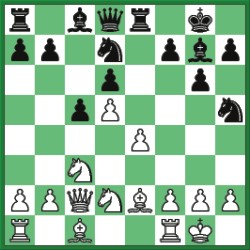|
Time
Out
An electrifying move! Chess
Classical
theorists have always been critical of any deviation from
their ideas. The pure form of chess, as one might call it,
has little room for trying anything that looks bad or anti-positional.
Of course, there is truth in their ideas. For example, you
are unlikely to gain anything by weakening the pawn position
in front of your king; moving the same piece again and again;
neglecting the development of a particular piece, and so on.
Weakness in the pawn structure becomes more pronounced, as
pawn positions have a more or less permanent character. So
you have to be extra cautious before leaving a pawn isolated,
doubled or backward. Such pawns can be an easy target for
the enemy artillery. A weakened pawn structure has other disadvantages
too. The opponent may take advantage of the holes created
due to a square being unguarded by a pawn. So, be careful!
Don't make unnecessary pawn moves, and never allow serious
rupturing in their formation.
Modern
chess thinkers, however, believe that classical theorists
have carried it a bit too far. First, a weakness is readily
acceptable if there is enough compensation for it. You won't
mind having doubled pawns on a file if that leads to a decisive
attack along an adjacent line. This was understood by masters
in the 19th century also, but there is more to it than the
mere physical appearance of a pawn structure. Chess today
is a highly dynamic proposition where the strength and weakness
of a pawn or piece cannot be assessed without carefully weighing
all the features of a particular position. Then again, a weakness
may not be significant if the enemy cannot exploit it! That's
the truth of the matter.
Bobby
Fischer, world champion (1972-75), was particularly known
for his dynamism. He would often take great risks for generating
lively play over the board. The move Nh5 in the following
game baffled most of the grandmasters who were watching it.
It amounted to deliberate spoiling of Black's position! The
doubled pawns on the h file really looked like having no future.
But the collective mobility of the black pieces triumphed
in the end!
White-
Boris V Spassky
Black-Robert James Fischer [A77]
World Championship 1972
1.d4 Nf6
2.c4 e6 3.Nf3 c5 4.d5 exd5 5.cxd5 d6 6.Nc3 g6 7.Nd2 Nbd7 8.e4
Bg7 9.Be2 00 10.00 Re8 11.Qc2 Nh5!? 12.Bxh5 gxh5 13.Nc4 Ne5
14.Ne3 Qh4 15.Bd2 Ng4 16.Nxg4 hxg4 17.Bf4 Qf6 18.g3? Bd7 19.a4
b6 20.Rfe1 a6 21.Re2 b5! 22.Rae1 Qg6 23.b3 Re7 24.Qd3 Rb8
25.axb5 axb5 26.b4 c4 27.Qd2 Rbe8 28.Re3 h5 29.R3e2 Kh7 30.Re3
Kg8 31.R3e2 Bxc3 32.Qxc3 Rxe4 33.Rxe4 Rxe4 34.Rxe4 Qxe4 35.Bh6
Qg6 36.Bc1 Qb1 37.Kf1 Bf5 38.Ke2 Qe4+ 39.Qe3 Qc2 40.Qd2 Qb3
41.Qd4? Bd3+! 0-1

Position
after 11...Nh5
-PATZER
Copyright
(R) thedailystar.net 2005
| 